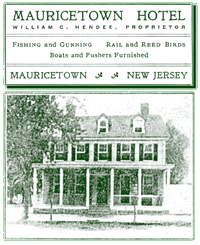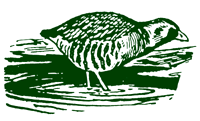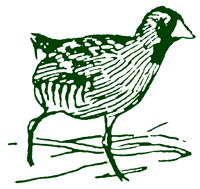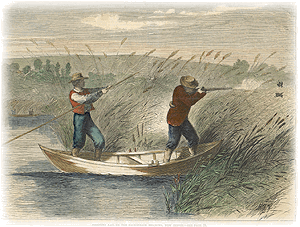 |
|
|||
Objectives Students will: Describe and illustrate the tradition of rail bird hunting including habitat, techniques, and behavior of the birds, the boat, and the hunter based on a simulated field trip Materials Copy of rail bird boat handout Pencil Art supplies including watercolor paints or other preferred medium for illustration Large roll of paper for mural (optional) Making Connections Rail bird hunting has been a long standing tradition in the Down Jersey region. An excerpt from Tide and Time by Pete Dunne, Charting a Course for the Delaware Bay Watershed, Harriet B. Honigfeld, New Jersey Conservation Foundation, 1997.
“President Benjamin Harris hunted these marshes a century ago and maybe he was pushed by a Camp. Teddy Roosevelt, the president who championed wildlife conservation, was likewise drawn, as was Philadelphia painter Thomas Eakins. So enamored of this esoteric brand of bird hunting was Eakins that he depicted the pageant no fewer than six times. What sort of bird can claim the favor of presidents and painters and place them in collusion with New Jersey baymen? Why, the sora rail, a small, chicken-like marsh bird that lofts into the air like a grasshopper, flies like the Wright Brothers, and falls like a stone a split instant before gunners loosen the charge of shot that passes, often as not, cleanly over the backs of the birds. “In the last quarter of the 19th century, over a hundred thousand soras a year were taken from the marshes flanking the Maurice —most by the 200-odd members of the long-ago disbanded West Jersey Game Protection Society. On one momentous tide, members were reported to have downed 21,000 birds — 365 felled by a single gun. “But this blend of innocence and slaughter died with the opulent century that spawned such excesses. As recorded in the ledgers of Ken Camp, an environmentally tempered 1,500 birds a year are currently killed by gunners, an average of ten birds per boat. While this may sound generous in an age where a single black duck constitutes the legal limit and canvasback may not be hunted at all, Ken Camp allows that the number of birds killed is consistent year to year. The host of birds and the harvest has fallen into harmony. “In all of North America, there are but a handful of coastal reaches where rails are still hunted in the traditional fashion. In New Jersey, only one. Here. Along the banks of the Maurice River . . . ” Background Hints for Using Simulated Field Trips The following is reprinted from Project WILD, pages 348-349 Western Regional Environmental Education Council, 1992. A simulated field trip is a powerful way for students to create vivid experiences in their mind’s eye. Many older people remember when the major form of entertainment was radio. With radio and its absence of visual images, many listeners were forced to create mental pictures of the way various characters looked and acted. It was common for listeners to see landscapes, cities, and any number of exotic settings. Often one hears teachers and parents claim that radio helped make students more creative as it required the listeners to stretch their imaginations. Many neuroscientists concur. Research has shown that, with their eyes closed, people activate parts of their brain-mind systems that are often left unstimulated. When we picture things in our minds, we call parts of our brains into activity that are unused in reading or writing. Studies show skill in picturing things in our minds enhances our ability to enrich reading and to increase skill and imagination in writing. The capacity to remember concepts, words, names and ideas is enhanced. Dramatic results have been achieved when these approaches are combined with medicine. In many instances, life-threatening illnesses have been reversed and overcome. The use of simulated field trips for instructional purposes is promising to become one of the most effective educational strategies of the past two decades. The following guidelines provide a basic, useful approach to the use of simulated field trips as a teaching tool.
In addition to serving as a powerful and effective way to explore and remember concepts, regular use of simulated field trips also tends to relax students. When relaxed, they will frequently be more productive in all academic areas — including scoring higher on standardized achievement tests. Procedure Warm Up If desired, show the segment of the video that deals with rail bird hunting. The Activity
Action Assessment Participation in class discussion and creation of the mural and/or illustration. Extensions Have students do other creative projects using the topic of rail bird hunting as a focus: poetry and stories. Students could make a mobile which includes all of the components of a rail bird hunt. Also, students could investigate and compare/contrast the other bird species that are (or were) regularly hunted along the tidal tributaries of the Delaware Estuary. Utilize rail bird hunting as a focus for interviewing people that have been rail bird hunting before. See Activity: Saving Local History. Please download the PDF for the complete Lesson Plan. Charting a Course for the Delaware Bay Watershed, Honigfeld, Harriet B. Other books related to waterfowl hunting. See especially, Shorebird Decoy Activity. |
|||

 The traditional sport of rail bird hunting is indicative of the historical use of the Maurice River. The Camp family is exclusively and intimately intertwined with all aspects of this recreational activity. The Camp family still organizes hunts and has exclusive domain over rail bird hunting to this day. Included in this activity is a descriptive account of the personal experience of Pete Dunne (New Jersey Audubon Society) on a recent rail bird hunting excursion. This activity examines the various components of this traditional and cultural significant use of the area’s resources. Through visualizing the details described by Pete Dunne, the students will re-create an illustration of rail bird hunting, using an actual diagram of the Camp rail bird boat.
The traditional sport of rail bird hunting is indicative of the historical use of the Maurice River. The Camp family is exclusively and intimately intertwined with all aspects of this recreational activity. The Camp family still organizes hunts and has exclusive domain over rail bird hunting to this day. Included in this activity is a descriptive account of the personal experience of Pete Dunne (New Jersey Audubon Society) on a recent rail bird hunting excursion. This activity examines the various components of this traditional and cultural significant use of the area’s resources. Through visualizing the details described by Pete Dunne, the students will re-create an illustration of rail bird hunting, using an actual diagram of the Camp rail bird boat. “Every year for four generations, the Camps of Port Elizabeth have poled gunners through the stands of wild rice that lines the banks of the Maurice River. When the axis of the earth inclines toward autumn and the winds turn chill, rail birds migrate south. They reach Delaware Bay’s marshes after a night of travel and gather in the rice beds, feasting on the grains. This is why sportsmen the world over travel to this obscure Bayshore community and for seventy-five dollars secure the services of the Camps — ‘for a (full) tide.’
“Every year for four generations, the Camps of Port Elizabeth have poled gunners through the stands of wild rice that lines the banks of the Maurice River. When the axis of the earth inclines toward autumn and the winds turn chill, rail birds migrate south. They reach Delaware Bay’s marshes after a night of travel and gather in the rice beds, feasting on the grains. This is why sportsmen the world over travel to this obscure Bayshore community and for seventy-five dollars secure the services of the Camps — ‘for a (full) tide.’ In some cases, the process serves simply to provide a visual review of some of the students’ past experiences. At other times, you are providing stimuli for the students to create original images. In any case, it is important to realize that there are no mistakes in mental images. What a student pictures is real. The images are data. If students create images that are inconsistent with what you expected, consider the images to represent differing perspectives rather than wrong answers. Try to honor and nourish variety as a means to add richness to the topics being explored.
In some cases, the process serves simply to provide a visual review of some of the students’ past experiences. At other times, you are providing stimuli for the students to create original images. In any case, it is important to realize that there are no mistakes in mental images. What a student pictures is real. The images are data. If students create images that are inconsistent with what you expected, consider the images to represent differing perspectives rather than wrong answers. Try to honor and nourish variety as a means to add richness to the topics being explored. Wrap Up
Wrap Up